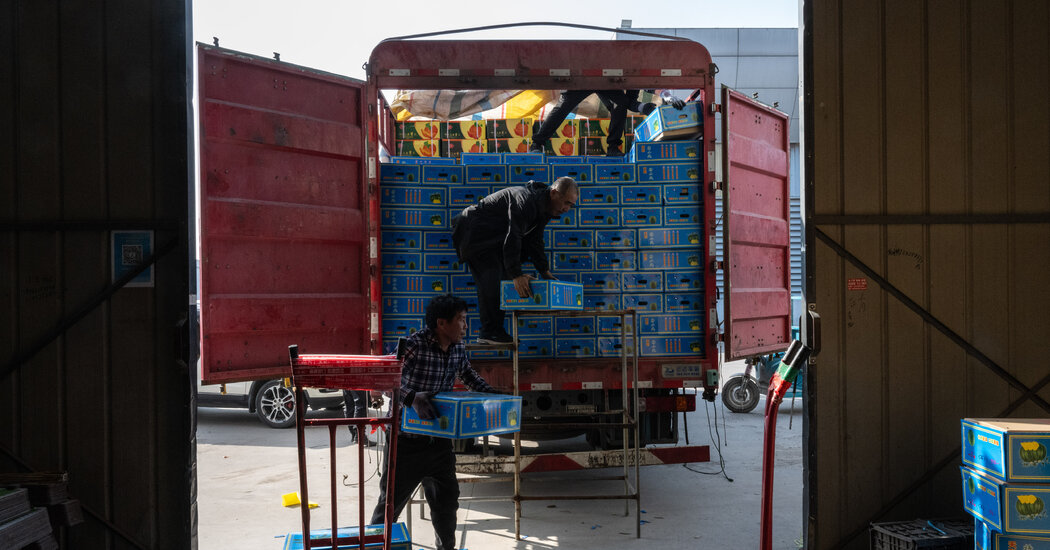China’s Addiction to Coal Deepens in the Heat
China has an answer to the heat waves now affecting much of the Northern Hemisphere: burn more coal to maintain a stable electricity supply for air-conditioning.
Even before this year, China was emitting almost a third of all energy-related greenhouse gases — more than the United States, Europe and Japan combined. China burns more coal every year than the rest of the world combined. Last month, China generated 14 percent more electricity than it did in June 2022, and the whole increase was generated by coal-fired plants.
China’s ability to ramp up coal usage in recent weeks is the result of a huge national campaign over the past two years to expand coal mines and build more coal-fired power plants. State media celebrated the industriousness of the 1,000 workers who toiled without vacations this spring to finish one of the world’s largest coal-fired power plants in southeastern China in time for summer.
The paradox of China’s energy policy is that the country also leads the world in installing renewables. It dominates most of the global supply chain for clean energy — from solar panels to battery storage to electric cars. Yet for reasons of energy security and domestic politics, it is doubling down on coal.
After three days of negotiations in Beijing, John Kerry, President Biden’s climate envoy, said on Wednesday that China’s coal program had been the hardest issue. “The question now is to shift from some of the coal dependency,” he said.
The United States, which emits far fewer greenhouse gases than China, is headed in a different direction. It has not built a new coal-fired plant in a decade, while nearly halving its coal use and increasing natural gas usage instead.
No country has underground coal reserves as large as those in China, where officials see domestic supplies as essential to energy security. Zhang Jianhua, director of the government’s National Energy Administration, described coal as the “ballast stone” of his country’s energy mix.
“Always regard the protection of national energy security as the most important mission,” he said at a news conference this spring.
China’s top leader, Xi Jinping, said in April 2021, that his country would “strictly control coal power projects, strictly control the growth of coal consumption” through 2025 and then “gradually reduce it” through the next five years. In mid-September 2021, he separately banned any further contracts for China to build coal-fired power plants in other countries.
A week later, in late September 2021, hot weather overloaded China’s electric grid and caused rolling blackouts up and down the country’s seaboard. Workers had only a few minutes’ warning to flee office high-rises before the elevators shut down. A sudden loss of power at a chemical factory led to an explosion that injured dozens of workers.
The debacle prompted an emergency effort to increase coal mining and build more coal-fired power plants in China. Russia’s invasion of Ukraine, and the subsequent halt to Russian energy supplies to Europe, has increased Beijing’s determination to rely on coal as the core of its energy security.
China mostly imports oil and natural gas, much of it arriving on sea lanes controlled by the navies of the United States or India, two geopolitical rivals. After partial meltdowns at three nuclear reactors in 2011 at Fukushima, in Japan, China has limited the construction of nuclear plants to a few locations close to the coast.
As of January, China had more than 300 coal-fired power plants in various stages of proposal, permitting or construction, according to Global Energy Monitor, a research group. That was two-thirds of coal-fired capacity being developed worldwide.
Contributing to the building boom: During the 2021 blackouts, Chinese provinces tried to hoard electricity and not sell it to other provinces. Many local and provincial governments have responded by trying to build coal-fired power plants within their borders.
“To build all this super-redundant coal power will push up our whole cost of energy,” said Ma Jun, director of the Institute of Public and Environmental Affairs, a Beijing-based environmental group.
Practically all of China’s new plants are being built by state-owned enterprises because private developers see the facilities as financially unviable, said David Fishman, a China electricity analyst at Lantau Group, a Hong Kong consulting firm.
While China is building ever more coal-fired plants, it also leads in solar and wind power. It has installed 3.5 times as much solar power capacity and 2.6 times as much wind power as the United States, according to the International Renewable Energy Association, an intergovernmental group in the United Arab Emirates.
China’s biggest wind and solar projects tend to be in sparsely populated western and northwestern regions, where the weather is sunny and windy much of the year.
But those sites are far from the provinces near the coast where most of the population lives and where many electricity-hungry companies are — and where the weather is generally cloudier and less windy.
Connecting vast solar panel farms and rows of wind turbines to the coastal areas has required the construction of ultrahigh-voltage power lines. China has built more miles of ultrahigh-voltage lines than the rest of the world combined.
One problem is that such lines are exorbitantly expensive. China’s power companies must purchase 200-meter wide strips of land for each line, over hundreds of miles. So to be cost effective, the lines need to transmit electricity around the clock. But the sun does not shine brightly all day and the wind does not blow all the time.
As a result, the majority of China’s new coal-fired power plants are being built in conjunction with wind and solar projects, to make sure that they can transmit power continuously, said Kevin Tu, a Beijing energy expert who is a nonresident fellow with the Center on Global Energy Policy at Columbia University.
Another big climate change problem posed by China’s continuing heavy use of coal is how it is mined. More than in most countries, China’s coal is mined underground, a practice that tends to release a lot of methane into the atmosphere. Methane is 20 to 80 times as potent as carbon dioxide in its warming effects in the atmosphere. Chinese physicists have estimated that a quarter of all methane emissions in China come from its more than 100,000 coal mines, mostly small mines long abandoned but still leaking gases.
One unanticipated force could help China reduce its reliance on coal: a meltdown in its real estate market.
Factories use two-thirds of China’s electricity, and the dominant users are the steel and cement mills and glass manufacturers that supply the country’s vast construction efforts.
But housing prices are falling because years of overbuilding have produced as many as 80 million empty apartments. Developers started construction on nearly a quarter fewer apartments in the first half of this year compared with a year earlier.
Yet even a housing slowdown will not reverse the mammoth coal investment China has just made. “All the coal that’s being added means that it’s harder for China to be more ambitious” in addressing climate change, said Michal Meidan, head of China energy research at the Oxford Institute for Energy Studies, an independent research group. “It potentially complicates a more aggressive timeline on emissions.”
Li You contributed research. Chris Buckley contributed reporting from Taipei, Taiwan; and Lisa Friedman from Beijing.


